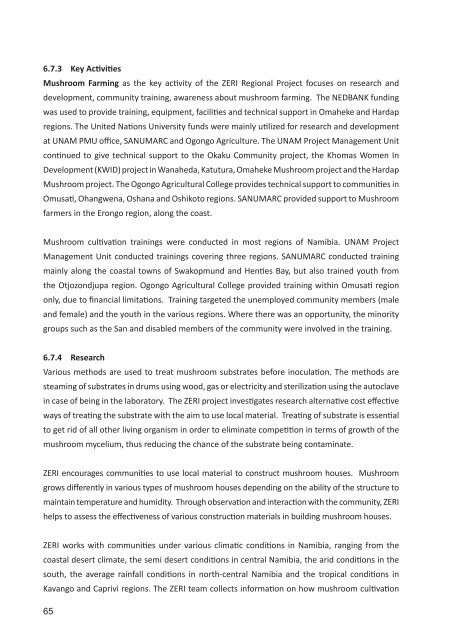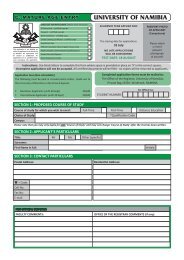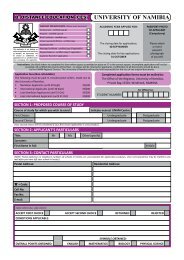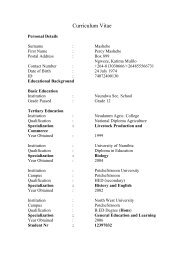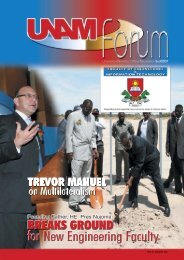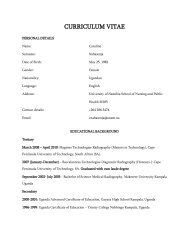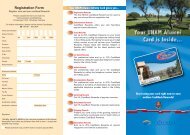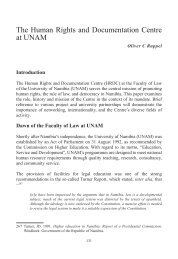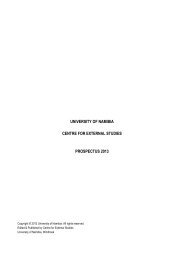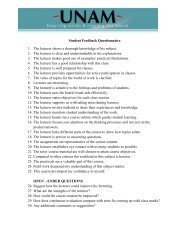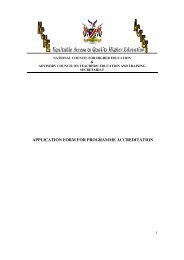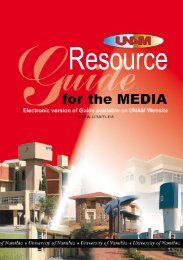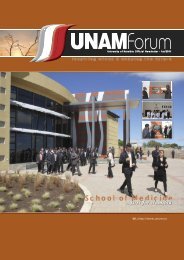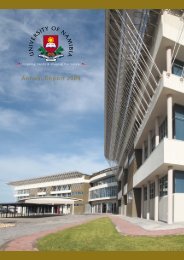Annual Report 2007 - University of Namibia
Annual Report 2007 - University of Namibia
Annual Report 2007 - University of Namibia
- No tags were found...
You also want an ePaper? Increase the reach of your titles
YUMPU automatically turns print PDFs into web optimized ePapers that Google loves.
6.7.3 Key ActivitiesMushroom Farming as the key activity <strong>of</strong> the ZERI Regional Project focuses on research anddevelopment, community training, awareness about mushroom farming. The NEDBANK fundingwas used to provide training, equipment, facilities and technical support in Omaheke and Hardapregions. The United Nations <strong>University</strong> funds were mainly utilized for research and developmentat UNAM PMU <strong>of</strong>fice, SANUMARC and Ogongo Agriculture. The UNAM Project Management Unitcontinued to give technical support to the Okaku Community project, the Khomas Women InDevelopment (KWID) project in Wanaheda, Katutura, Omaheke Mushroom project and the HardapMushroom project. The Ogongo Agricultural College provides technical support to communities inOmusati, Ohangwena, Oshana and Oshikoto regions. SANUMARC provided support to Mushroomfarmers in the Erongo region, along the coast.Mushroom cultivation trainings were conducted in most regions <strong>of</strong> <strong>Namibia</strong>. UNAM ProjectManagement Unit conducted trainings covering three regions. SANUMARC conducted trainingmainly along the coastal towns <strong>of</strong> Swakopmund and Henties Bay, but also trained youth fromthe Otjozondjupa region. Ogongo Agricultural College provided training within Omusati regiononly, due to financial limitations. Training targeted the unemployed community members (maleand female) and the youth in the various regions. Where there was an opportunity, the minoritygroups such as the San and disabled members <strong>of</strong> the community were involved in the training.6.7.4 ResearchVarious methods are used to treat mushroom substrates before inoculation. The methods aresteaming <strong>of</strong> substrates in drums using wood, gas or electricity and sterilization using the autoclavein case <strong>of</strong> being in the laboratory. The ZERI project investigates research alternative cost effectiveways <strong>of</strong> treating the substrate with the aim to use local material. Treating <strong>of</strong> substrate is essentialto get rid <strong>of</strong> all other living organism in order to eliminate competition in terms <strong>of</strong> growth <strong>of</strong> themushroom mycelium, thus reducing the chance <strong>of</strong> the substrate being contaminate.ZERI encourages communities to use local material to construct mushroom houses. Mushroomgrows differently in various types <strong>of</strong> mushroom houses depending on the ability <strong>of</strong> the structure tomaintain temperature and humidity. Through observation and interaction with the community, ZERIhelps to assess the effectiveness <strong>of</strong> various construction materials in building mushroom houses.ZERI works with communities under various climatic conditions in <strong>Namibia</strong>, ranging from thecoastal desert climate, the semi desert conditions in central <strong>Namibia</strong>, the arid conditions in thesouth, the average rainfall conditions in north-central <strong>Namibia</strong> and the tropical conditions inKavango and Caprivi regions. The ZERI team collects information on how mushroom cultivation65


